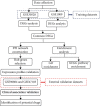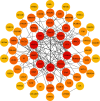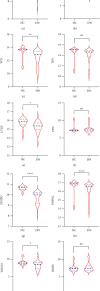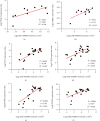Integrated Bioinformatics and Clinical Correlation Analysis of Key Genes, Pathways, and Potential Therapeutic Agents Related to Diabetic Nephropathy
- PMID: 35637650
- PMCID: PMC9148260
- DOI: 10.1155/2022/9204201
Integrated Bioinformatics and Clinical Correlation Analysis of Key Genes, Pathways, and Potential Therapeutic Agents Related to Diabetic Nephropathy
Abstract
Background: Diabetic nephropathy (DN) is a common microvascular complication of diabetes and a major cause of end-stage renal disease, resulting in a substantial socioeconomic burden around the world. Some unknown biomarkers, mechanisms, and potential novel agents regarding DN are yet to be identified.
Methods: GSE30528 and GSE1009 were downloaded as training datasets to identify differentially expressed genes (DEGs) of DN. Common DEGs were selected for further analysis. Gene Ontology and Kyoto Encyclopedia of Genes and Genomes (KEGG) analyses of DEGs were performed to explore molecular mechanisms and pathways. Protein-protein interaction (PPI) network of DEGs was used to identify the top 10 hub genes of DN. Expression profiles of the hub genes were validated in GSE96804 and GSE47183 datasets. The clinical correlation analyses were conducted to confirm the association between key genes and clinical characteristics in the Nephroseq v5 database. The Drug Gene Interaction Database was used to predict potential targeted drugs.
Results: 345 and 1228 DEGs were identified in GSE30528 and GSE1009, respectively; and 120 common DEGs were found. The biological process of DEGs was significantly enriched in kidney development. PI3K-Akt signaling pathway, focal adhesion, complement and coagulation cascades were significantly enriched KEGG pathways. The identified top10 hub genes were VEGFA, NPHS1, WT1, TJP1, CTGF, FYN, SYNPO, PODXL, TNNT2, and BMP2. VEGFA, NPHS1, WT1, CTGF, SYNPO, PODXL, and TNNT2 were significantly downregulated in DN. VEGFA, NPHS1, WT1, CTGF, SYNPO, and PODXL were positively correlated with glomerular filtration rate. The targeted drugs or molecular compounds were enalapril, sildenafil, and fenofibrate target for VEGFA; losartan target for NPHS1; halofuginone, deferoxamine, curcumin, and sirolimus target for WT1; and purpurogallin target for TNNT2.
Conclusions: VEGFA, NPHS1, WT1, CTGF, SYNPO, and PODXL are promising biomarkers for diagnosing and evaluating the progression of DN. The drug-gene interaction analyses provide a list of candidate drugs for the precise treatment of DN.
Copyright © 2022 Shengnan Chen et al.
Conflict of interest statement
The authors declare that there is no conflict of interest regarding the publication of this article.
Figures









Similar articles
-
Integrating bioinformatics and machine learning to identify glomerular injury genes and predict drug targets in diabetic nephropathy.Sci Rep. 2025 May 15;15(1):16868. doi: 10.1038/s41598-025-01628-5. Sci Rep. 2025. PMID: 40374840 Free PMC article.
-
Screening and Identification of Differentially Expressed Genes Between Diabetic Nephropathy Glomerular and Normal Glomerular via Bioinformatics Technology.Comb Chem High Throughput Screen. 2021;24(5):645-655. doi: 10.2174/1386207323999200821163314. Comb Chem High Throughput Screen. 2021. PMID: 32954999
-
Investigation of the Mechanism of Complement System in Diabetic Nephropathy via Bioinformatics Analysis.J Diabetes Res. 2021 May 24;2021:5546199. doi: 10.1155/2021/5546199. eCollection 2021. J Diabetes Res. 2021. PMID: 34124269 Free PMC article.
-
Network pharmacology-based identification of miRNA expression of Astragalus membranaceus in the treatment of diabetic nephropathy.Medicine (Baltimore). 2022 Feb 4;101(5):e28747. doi: 10.1097/MD.0000000000028747. Medicine (Baltimore). 2022. PMID: 35119030 Free PMC article.
-
Analysis of the potential molecular biology of triptolide in the treatment of diabetic nephropathy: A narrative review.Medicine (Baltimore). 2022 Dec 2;101(48):e31941. doi: 10.1097/MD.0000000000031941. Medicine (Baltimore). 2022. PMID: 36482625 Free PMC article. Review.
Cited by
-
PRKD2 as a novel target for targeting the diabetes-osteoporosis nexus.Sci Rep. 2025 Feb 8;15(1):4703. doi: 10.1038/s41598-025-89235-2. Sci Rep. 2025. PMID: 39922871 Free PMC article.
-
Single-cell RNA and transcriptome sequencing profiles identify immune-associated key genes in the development of diabetic kidney disease.Front Immunol. 2023 Mar 29;14:1030198. doi: 10.3389/fimmu.2023.1030198. eCollection 2023. Front Immunol. 2023. PMID: 37063851 Free PMC article.
-
Next-Generation Sequencing for the Detection of Microbial Agents in Avian Clinical Samples.Vet Sci. 2023 Dec 4;10(12):690. doi: 10.3390/vetsci10120690. Vet Sci. 2023. PMID: 38133241 Free PMC article. Review.
-
High-Dose Fenofibrate Stimulates Multiple Cellular Stress Pathways in the Kidney of Old Rats.Int J Mol Sci. 2024 Mar 6;25(5):3038. doi: 10.3390/ijms25053038. Int J Mol Sci. 2024. PMID: 38474282 Free PMC article.
References
MeSH terms
LinkOut - more resources
Full Text Sources
Medical
Research Materials
Miscellaneous

